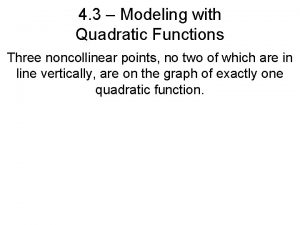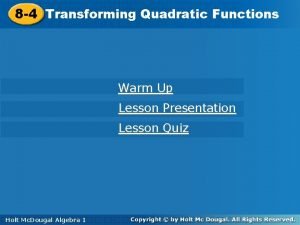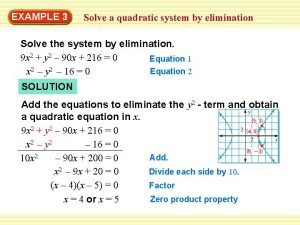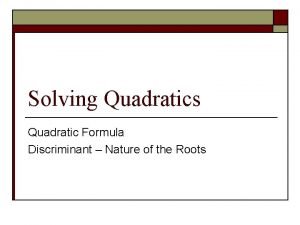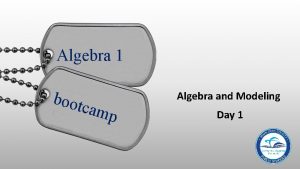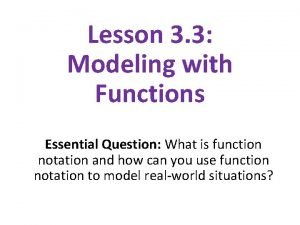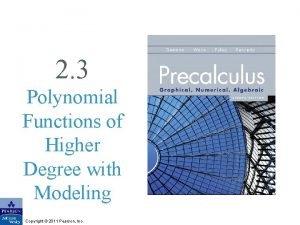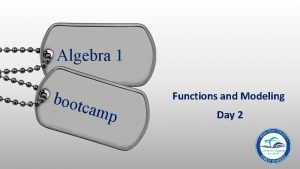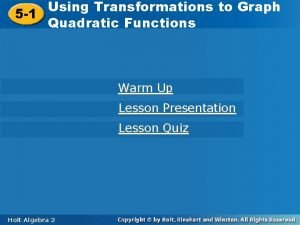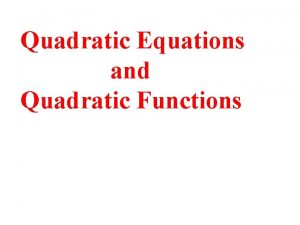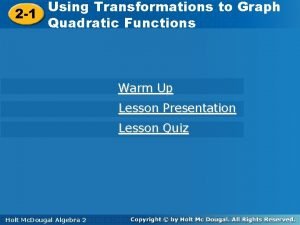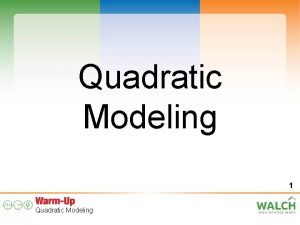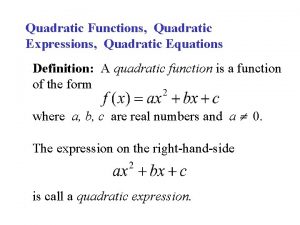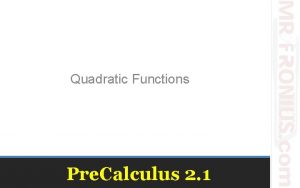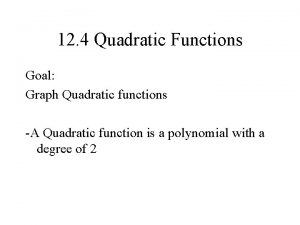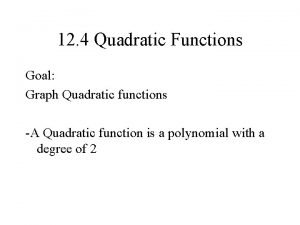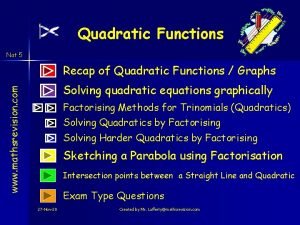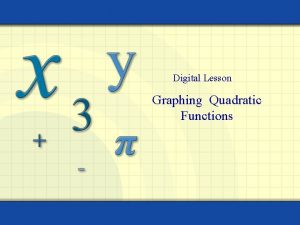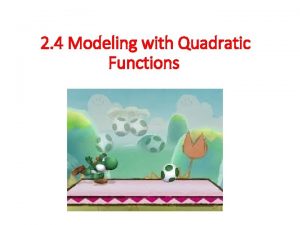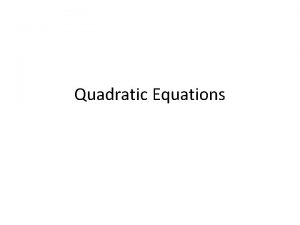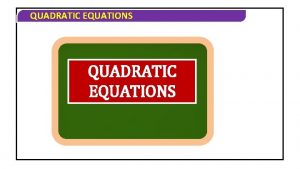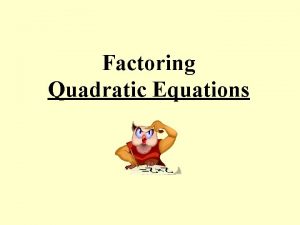5 8 Modeling with Quadratic Functions Modeling with

















- Slides: 17

5. 8 Modeling with Quadratic Functions

Modeling with Quadratic Functions Depending on what information we are given will determine the form that is the most convenient to use.

Graphing 2 y=x Standard Vertex y = ax 2+bx+c y= a (x - h)2+k axis: x = h vertex ( x , y ) vertex ( h , k ) C is y-intercept a>0 U shaped, Minimum a<0 ∩ shaped, Maximum

1. Write a quadratic function for the parabola shown. Use vertex form because the vertex is given. y = a(x – h)2 + k Vertex form y = a(x – 1)2 – 2 Substitute 1 for h and – 2 for k. Use the other given point, (3, 2), to find a. Substitute 3 for x and 2 for y. 2 = a(3 – 1)2 – 2 Simplify coefficient of a. 2 = 4 a – 2 Solve for a. 1=a A quadratic function for the parabola is y = 1(x – 1)2 – 2.

2. Write a quadratic function whose graph has the given characteristics. vertex: (4, – 5) passes through: (2, – 1) Use vertex form because the vertex is given. Vertex form y = a(x – h)2 + k y = a(x – 4)2 – 5 Substitute 4 for h and – 5 for k. Use the other given point, (2, – 1), to find a. Substitute 2 for x and – 1 for y. – 1 = a(2 – 4)2 – 5 Simplify coefficient of x. – 1 = 4 a – 5 Solve for a. 1=a ANSWER A quadratic function for the parabola is y = 1(x – 4)2 – 5.

3. vertex: (– 3, 1) passes through: (0, – 8) Use vertex form because the vertex is given. y = a(x – h)2 + k Vertex form y = a(x + 3)2 + 1 Substitute – 3 for h and 1 for k. Use the other given point, (0, – 8), to find a. Substitute 2 for x and – 8 for y. – 8 = a(0 + 3)2 + 1 Simplify coefficient of x. – 8 = 9 a + 1 Solve for a. – 1 = a ANSWER A quadratic function for the parabola is y = 1(x + 3)2 + 1.

Steps for solving in 3 variables 1. Using the 1 st 2 equations, cancel one of the variables. 2. Using the last 2 equations, cancel the same variable from step 1. 3. Use the results of steps 1 & 2 to solve for the 2 remaining variables. 4. Plug the results from step 3 into one of the original 3 equations and solve for the 3 rd remaining variable. 5. Write the quadratic equation in standard form.

4. Write a quadratic function in standard form for the parabola that passes through the points (– 1, – 3), (0, – 4), and (2, 6). STEP 1 Substitute the coordinates of each point into y = ax 2 + bx + c to obtain the system of three linear equations shown below. – 3 = a(– 1)2 + b(– 1) + c Substitute – 1 for x and -3 for y. – 3 = a – b + c Equation 1 – 4 = a(0)2 + b(0) + c – 4=c 6 = a(2)2 + b(2) + c Substitute 0 for x and – 4 for y. 6 = 4 a + 2 b + c Equation 2 Substitute 2 for x and 6 for y. Equation 3

STEP 2 Rewrite the system of three equations in Step 1 as a system of two equations by substituting – 4 for c in Equations 1 and 3. a–b+c=– 3 a–b– 4=– 3 a–b=1 4 a + 2 b + c = 6 4 a + 2 b - 4 = 6 4 a + 2 b = 10 Equation 1 Substitute – 4 for c. Revised Equation 1 Equation 3 Substitute – 4 for c. Revised Equation 3

STEP 3 Solve the system consisting of revised Equations 1 and 3. Use the elimination method. a–b=1 4 a + 2 b = 10 2 a – 2 b = 2 4 a + 2 b = 10 6 a = 12 a=2 So 2 – b = 1, which means b = 1. The solution is a = 2, b = 1, and c = – 4. ANSWER A quadratic function for the parabola is y = 2 x 2 + x – 4.

5. Write a quadratic function in standard form for the parabola that passes through the given points. (– 1, 5), (0, – 1), (2, 11) STEP 1 Substitute the coordinates of each point into y = ax 2 + bx + c to obtain the system of three linear equations shown below. 5 = a(– 1)2 + b(– 1) + c Substitute – 1 for x and 5 for y. 5=a–b+c Equation 1 – 1 = a(0)2 + b(0) + c – 1=c Substitute 0 for x and – 1 for y. 11 = a(2)2 + b(2) + c Substitute 2 for x and 11 for y. 11 = 4 a + 2 b + c Equation 3 Equation 2

STEP 2 Rewrite the system of three equations in Step 1 as a system of two equations by substituting – 1 for c in Equations 1 and 3. a–b+c=5 a–b– 1=5 a–b=6 4 a + 2 b + c = 11 4 a + 2 b – 1 = 11 4 a + 2 b = 12 Equation 1 Substitute – 1 for c. Revised Equation 1 Equation 3 Substitute – 1 for c. Revised Equation 3

STEP 3 Solve the system consisting of revised Equations 1 and 3. Use the elimination method. a–b=6 4 a + 2 b = 10 2 a – 2 b = 12 4 a + 2 b = 12 6 a = 24 a= 4 So, 4 – b = 6, which means b = – 2 ANSWER A quadratic function for the parabola is y = 4 x 2 – 2 x – 1

6. (1, 0), (2, -3), (3, -10) STEP 1 Substitute the coordinates of each point into y = ax 2 + bx + c to obtain the system of three linear equations shown below. 0 = a(1)2 + b(1) + c 0= 1 a + 1 b + c Substitute 1 for x and 0 for y. Equation 1 -3 = a(2)2 + b(2) + c -3 = 4 a +2 b + c Substitute 2 for x and- 3 for y. -10 = a(3)2 + b(3) + c Substitute 3 for x and -10 for y. -10 = 9 a + 3 b + c Equation 3 Equation 2

STEP 2 Rewrite the system of three equations in Step 1 as a system of two equations. Use Elimination to simplify one set of equations then use substitution & elimination to find the PART 1 Equation 2 0 = 1 a + 1 b + c -1 -3 = 4 a +2 b + c PART 2 Equation 2 -3 = 4 a +2 b + c Equation 3 -10 = 9 a + 3 b + c PART 1 PART 2 -3 = 3 a +1 b -7 = 5 a + 1 b -1 -1 0 = -1 a - 1 b - c -3 = 4 a +2 b + c -3 = 3 a +1 b PART 1 3 = -4 a -2 b - c -10 = 9 a + 3 b + c -7 = 5 a + 1 b PART 2 3 = -3 a - 1 b -7 = 5 a + 1 b -4 = 2 a -2 = a

STEP 3 Solve for the remaining variables by substitution. Original equations 0 = 1 a + 1 b + c -3 = 4 a +2 b + c -10 = 9 a + 3 b + c -3 = 3 a +1 b PART 1 -7 = 5 a + 1 b PART 2 -2 = a -3 = 3(-2) +1 b -3 = -6 +1 b 3=b 0 = 1 a + 1 b + c 0 = 1(-2) + 1(3) + c 0 = -2 + 3 + c 0=1+c -1 = c

Substitute -2 = a 3=b -1 = c y = ax 2 + bx + c y= 2 -2 x + 3 x -1 FINAL ANSWER!!
 Linear and quadratic functions and modeling
Linear and quadratic functions and modeling 4-3 modeling with quadratic functions
4-3 modeling with quadratic functions Transformation of quadratic functions calculator
Transformation of quadratic functions calculator Relational modeling vs dimensional modeling
Relational modeling vs dimensional modeling Model and role modeling theory
Model and role modeling theory Solving quadratic systems by elimination
Solving quadratic systems by elimination Example of a quadratic equation
Example of a quadratic equation Algebra 1 bootcamp
Algebra 1 bootcamp 3-3 modeling with functions
3-3 modeling with functions Algebra 1 bootcamp functions and modeling
Algebra 1 bootcamp functions and modeling Polynomial functions of higher degree with modeling
Polynomial functions of higher degree with modeling Algebra 1 bootcamp functions and modeling answer key
Algebra 1 bootcamp functions and modeling answer key Algebra 1 bootcamp functions and modeling answer key
Algebra 1 bootcamp functions and modeling answer key Real life sinusoidal examples
Real life sinusoidal examples Using transformations to graph quadratic functions
Using transformations to graph quadratic functions Quadratic functions vocabulary
Quadratic functions vocabulary Quadratic functions exercises
Quadratic functions exercises Transformations of quadratic functions
Transformations of quadratic functions

